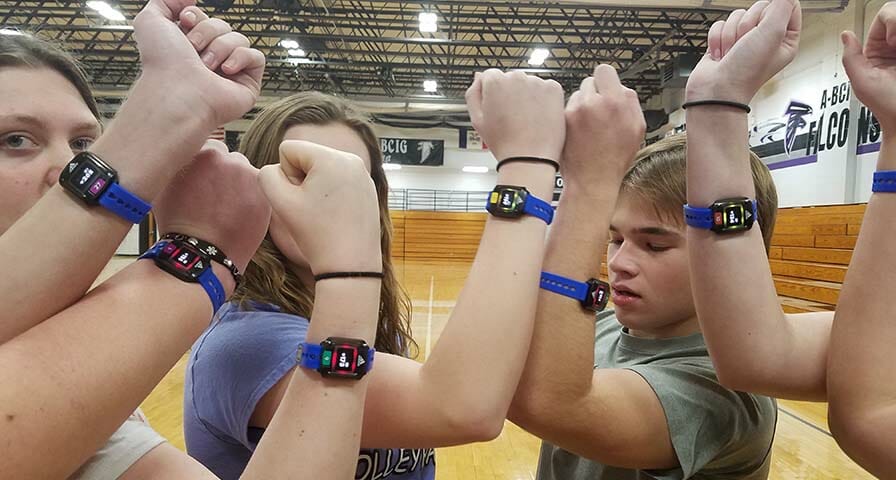By wearing PE heart rate monitors during class, students learn to improve their heart rate training performance by comparing their perceived effort level with their actual effort level.
Through a study with homeschool students in Kearney, Neb., Danielle Tilley used IHT Zone wrist heart rate monitors to test the students’ perceptions versus reality during a weekly PE class. Students wore the monitors while exercising at different levels – walking, jogging and sprinting for one-minute intervals. After each sprint, students let Tilley know how hard they exercised based on the Borg Scale of Perceived Exertion.
“With the walk and sprint test, they were pretty accurate in estimating their perception, but that’s expected,” Tilley said. “When you’re not tired, it’s really easy to tell that, and when you’re out of breath, it’s really easy to tell that.”
Students generally felt, especially during the sprint sessions, that they were giving maximum effort. The data, displayed through IHT’s Spirit Assessment Measures software, showed otherwise.
“When we did the sprinting test, their estimates of their perception were a little higher than actual,” she said. “They think they are giving their all but really they weren’t quite giving their all.”
Tilley said she expected students to think they worked harder than the data showed. The level between rest and maximum exertion can be tough to measure.
“But when you’re in between those, it’s hard to tell exactly where you are,” she said. “They thought they were in better shape than they are.”
A junior at the University of Nebraska-Kearney, the data Tilley collected from her study earned her a trip to Washington, DC, as a Posters on the Hill winner in the 2018 Council for Undergraduate Research. An aspiring PE teacher, she begins student teaching in the fall and plans to duplicate her study with her students while adding a key element: teaching students what the data means.
“I would love to see their reactions and try to explain to them how ‘you said you were this, but you were really this’ when it comes to exertion,” she said. “Either they think they are in better shape than they are or they are in better shape than they think. If we can do that, then maybe they will comprehend what we’re doing a little bit better.”
More experienced teachers have already had success getting students to understand what their actual heart rate data tells them compared to what they originally thought about their effort, in particular students who are fit and have to push themselves to get their heart rate up. Teachers want to see students:
- Understand how to exercise in a specific heart rate zone
- Use the heart rate monitor to stay in the target heart rate zone
- The ability to reach and maintain a target heart rate zone without using a heart rate monitor
“Being a track athlete and being as fit as I am, it showed me how much I actually have to work to get into that zone,” said Justin Lehmkuhler, who conducted a research project of his own as an 8th grader under teacher Rick Carr’s guidance. “I can’t just take it light and train light if I want to improve.”
“[As an adult], I know how hard is too hard for me, and I know how hard is not hard enough,” said Doug Hallberg, whose Draper Middle School students have used the Zone monitors during their classes. “At 11, kids don’t know that at all and that is evidenced by if you say ‘go,’ some kids start out at a dead sprint and then can’t maintain and other kids start off at a walk and say ‘that’s as hard as I can go.’”
The feedback they receive from their wrist monitors help them manage their effort accordingly. The fastest learners, Hallberg said, learn to give their maximum effort without needing the monitors.
“The colors and numbers [the Zone displays] help us give them bio-feedback about where they are,” he said. “The goal for me is that you come into my class and say, ‘you know Mr. Hallberg, I can do this without the lights, without the numbers.’ And I can turn it all off, and if that student can reproduce what I’m looking for without that feedback, then I know they’ve truly learned the most valuable thing I can teach them, and that’s perceived exertion.”




